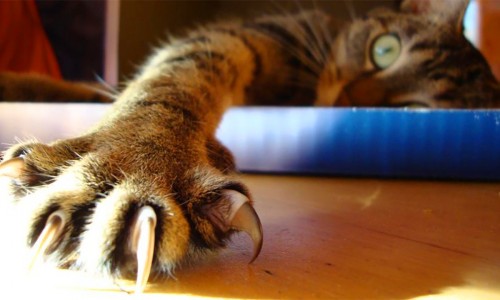Cat lovers everywhere are tuned in to the controversy of cat declawing procedures. Until recently, it was a routine step in virtually every cat’s adoption. Declawing cats made them tame and domesticated, safe to bring around children. However, New York veterinarians as well as many advocates are lobbying to make the procedure illegal, claiming that it is inhumane.

“Too often, people think that declawing is a simple surgery that removes a cat’s nails — the equivalent of having your fingernails trimmed,” The Humane Society explains. “Declawing traditionally involves the amputation of the last bone of each toe. If performed on a human being, it would be like cutting off each finger at the last knuckle.”
Many illegalization advocates say that there are no real benefits to cats. In fact, most argue that declawing can actually harm cats more than help them. While it is convenient to cuddle up to Mr. Fluffball without having to worry about him scratching up the new leather couch, the declawing procedure may not be worth it.
According to The Humane Society, studies show that cats are more likely to bite if they are declawed, due to their need to protect themselves. Instead of solving supposed behavioral problems, declawing cats can actually lead to the development of new, more serious problems.
After the procedure is completed, cats often trod on newspaper-covered litter boxes to avoid irritation of the wounds. However, cats tend not to adapt well to this substitute, and as a result, may stop using the litter box altogether.

Cat declawing also robs cats of their ability to perform an action that is inherently part of their nature: scratching. According to Johnson-Bennett in her book, Think Like a Cat, scratching is considered normal behavior for cats. In addition to helping relieve stress, scratching allows cats to stretch their muscles, mark their territory, and in essence, “file” their nails, which is a healthy part of self-grooming.

New York Veterinarians are speaking up about this issue, pushing for a change they believe to be occurring far too late, compared to other nations. So far, over 130 vets have voiced their approval of the bill, and it currently is under governmental debate, awaiting a final vote. Vets say that the only excuse for this painful procedure is if the cat physically needs its claws removed due to a serious infection that is causing it pain.
“It’s a disfiguring, inhumane and misguided procedure,” expresses Eileen Jefferson, an Ulster County veterinarian in her interview with the Huffington Post.
On the other hand, adversaries to the proposed bill claim that declawing cats is more than just a convenience to owners with nice upholstery; it is a procedure that can save cat’s lives. Many cats who use their claws to destruct are at risk of being given away to shelters, or eventually euthanized.
While this procedure is not quick and painless, it may give hope to cats without homes. Furthermore, some opposing cat-owners claim that in extreme cases, when cats are beyond training, declawing should be acceptable. They insist that vets are obligated to explain the process and risks of the procedure, but it is the owner’s choice to go through with it or not.

“We’re seeing it in significantly lower numbers because vets are educating clients on the alternatives that are available,” says Susan Wylegala, president of the New York State Veterinary Medical Society. “It needs to remain that last option.”
Watch this AP video for coverage of the proposed bill to ban the surgical procedure to declaw cats:
As of now, advocates are calling for an increase in awareness on this issue as they await the government’s response. Drew Weigner, Atlanta veterinarian and former president of the Academy of Feline Medicine, summarizes advocates’ point of view with Web MD, saying “I think it really boils down to [the fact that] cats are born with claws, and they should keep them.”
Remember to share this article with friends and family that love cats.

